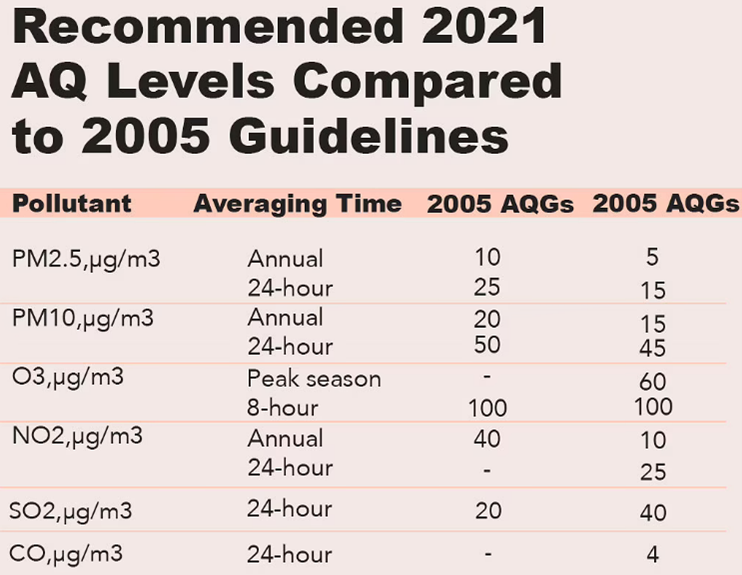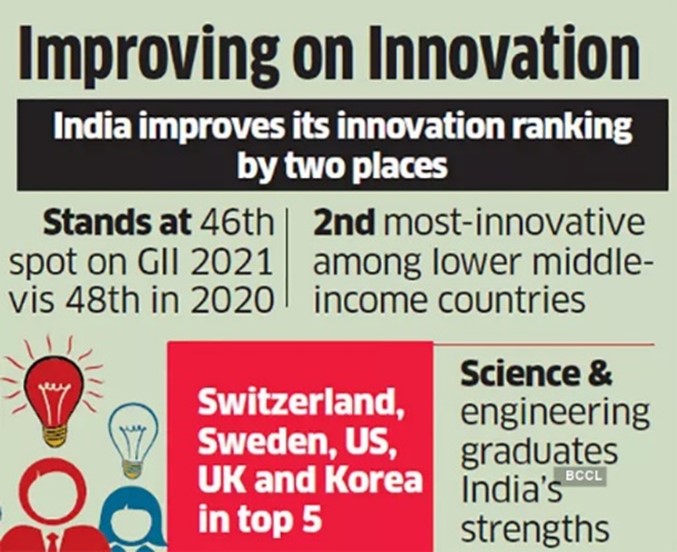Friday, 24th September 2021
Arjun Mk-1A tanks
In News
The Ministry of Defence has sealed a contract with the Heavy Vehicles Factory (HVF), Avadi, Chennai to procure 118 Main Battle Tanks Arjun for the Indian Army to boost its combat capabilities.
About the Main Battle Tank (MBT) Mk-1A
- Indigenous with added features: The MBT Mk-1A is a new variant of Arjun Tank designed to enhance fire power, mobility and survivability, infused with 72 new features and more indigenous content from the Mk-1 variant.
- Designed by: The tank has been designed and developed by the Combat Vehicles Research and Development Establishment (CVRDE) along with the DRDO.
- Armour: Known as the “hunter killers”, the latest version of the tank is equipped with a massive 120 mm rifled gun and Kanchan armour, making it the most potent armoured system in the army.
- Mode of operation: The tank, can take on the enemy during day and night conditions and in both static and dynamic modes. It has a computer-controlled integrated fire control system with stabilized sighting that works in all lighting conditions.
- Protection of Frontiers: This tank is particularly configured and designed for Indian conditions and hence it is suitable for deployment to protect the frontiers in an effective manner
- Secondary weapons: The secondary weapons include a co-axial 7.62-mm machine gun for anti-personnel and a 12.7-mm machine gun for anti-aircraft and ground targets.
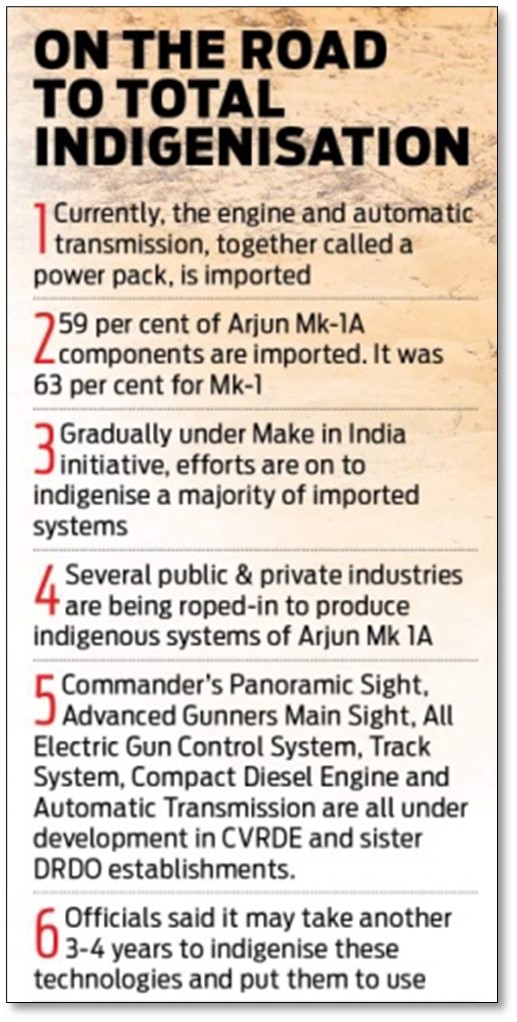
Concerns w.r.t Arjun Mk-1A
- Weight: The tank weighs 68.25 tonnes, making it among the world’s heaviest.
- Transportation issue: Transportability of the tank owing to its weight is an issue. Even, the Airlifting of this tank is not possible. Lighter tanks in the mountains are needed to suit the changing dynamics.
- The Arjun Mk-1A can’t easily be transported on trains because this requires building dedicated Mobile Bogie Well Wagons used by the Railways to transport military equipment.
- Logistical system mismatch: The entire Indian logistics support system is created and fine-tuned for medium-weight tanks and thus it becomes strenuous to create a parallel network for just four regiments of Arjun MBT, which is more or less a desert theatre-specific system.
Significance of Production of Arjun Mk-1A
- Employment Generation: The production of these tanks will open up avenues in defence manufacturing for over 200 Indian vendors with employment opportunities to around 8,000 people.
- Showcase Indigenous Capability: This will be a flagship project showcasing the indigenous capability in cutting edge defence technologies.
- Boost Make in India: It will provide further boost to the 'Make in India' initiative in defence sector and is a big step towards achieving 'Aatmanirbhar Bharat'.
Sources:
- Why India's order for 118 Arjun Mk-1A tanks for Rs 7,523 crore is a big deal
- Combat boost: Order placed for 118 Arjun Mk-1A tanks
Image Source:
Comprehensive Economic Partnership Agreement (CEPA)
In News
India and the UAE have formally launched negotiations on the India-United Arab Emirates CEPA.
About the News
- Both sides will aim to conclude negotiations by December 2021 and sign a formal agreement in March 2022 after the completion of internal legal procedures and ratification.
- The new strategic economic agreement is expected to increase bilateral trade in goods to $100 billion within five years of the signed agreement and increase trade in services to $15 billion.
- The CEPA is expected to create new jobs, raise living standards, and provide wider social and economic opportunities in both nations.
- The UAE is currently (2019-20) India’s third-largest trading partner, second-largest export destination after the US. The UAE is also the eighth-largest investor in India.
What is CEPA and how CEPA is different from Free Trade Agreement (FTA)?
- The CEPA is a bilateral agreement that covers trade in goods and services, investment, competition and intellectual property rights (IPRs).
- Unlike FTA, which is a free trade agreement, CEPA aims at lowering trade barriers instead of complete elimination.
- India already has CEPA with South Korea and Japan.
Expected benefits of signing such trade agreements for India
- Tariff Concession: These agreements provide tariff concessions thereby giving opportunities for exports of products including those related to small and medium enterprises (SMEs). Like the new strategic economic agreement is expected to increase bilateral trade in goods to $100 billion within five years.
- Improves market access: These agreements give easier and competitive access to the exporters as well as importers in the partner countries.
- Increased diversification: Increasing the diversification in terms of product basket and diversification countries help in hedging the unfavourable consequences on global and national trade due to geopolitical turmoil.
- Skill and technology transfer: Increased trade leads to better integration of market and also facilitate transfer of skills and technology.
Sources:
- India, UAE formally launch CEPA negotiations
- India UAE launched CEPA negotiations
- Advantages of trade agreements
Stubble- burning mitigation
In News
Recently, the Union government, its agencies and the state governments have stepped up efforts to tackle widespread stubble burning in the North India.
About the news
- The state of India’s air quality has taken the centre stage ahead of peak pollution days, with the Union and state governments moving to tackle widespread stubble burning in North India.
- As per WHO’s new guidelines the concentration of over 15 micrograms of PM2.5 per cubic meter is not safe (earlier 25 micrograms a cubic metre). This puts the whole of India under dangerous air quality levels.
- Stubble burning is a common practice followed by farmers to prepare fields for sowing of winter crops (Rabi crops). As there is little time left between the harvesting and sowing of next crop due to short winters. Therefore, burning is the cheapest and fastest way to get rid of the stubble
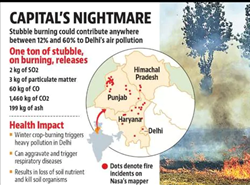
What are the Measures undertaken by the Centre and State governments to address Stubble Burning?
- Draft air pollution norms: The Union government had earlier commissioned the Indian Institute of Technology at Kanpur to draft air pollution norms for the country, but the norms are yet to be released.
- State Action Plans: The Union Ministry of Environment, Forest and Climate Change (MoEFCC) with other five key agriculture states of Punjab, Haryana, Rajasthan, Uttar Pradesh, Delhi, submitted an action plan to deal with the stubble burning.
- Farm Stubble Bio-pellets: The Union Ministry of Power along with state-owned power generator NTPC would procure 20 million tonnes of bio-pellets made of farm stubble to use these pellets as fuel along with coal.
- Bio-decomposition: The Indian Council of Agricultural Research (ICAR) has carried out a project on bio-decomposition in the five states.
- Use as Cattle Feed: The ministry has also set up a task force to look into the usage of stubble as cattle feed. Kutch in Gujarat and Jaisalmer in Rajasthan have been identified as two regions where stubble can be transported for cattle feed due to high demand from the areas.
- Commission for Air Quality Management (CAQM): The Union government had come out with a law in October 2020 to tackle pollution in NCR Delhi. The law provided for the constitution of CAQM under the Environment Protection Act (EPA) 1986.
- The Commission for Air Quality Management in National Capital Region and Adjoining Areas Ordinance 2020.
- Technological Intervention: Subsidised Happy Seeder machines, paddy straw choppers, reversible mould board (RMB) ploughs, zero till drills, straw management system (SMS) with harvest combines, rotary slasher machines and rotavators to decompose the straws have been introduced. But concerns were raised on its affordability and effectiveness.
- SC Directive: The Supreme Court had directed the Union agriculture and farmers welfare ministry to legislate a 100% centrally-funded scheme, under which machines that help farmers in in-situ management by tilling the stubble back into the soil are to be provided to individual farmers at 50% subsidy and to custom hiring centres (CHCs) at 80% subsidy.
Sources:
This Day in History - Satyashodhak Samaj
On September 24, 1873, Satyashodhak Samaj, the ‘Truth-Seeking Society’ was founded by Jyotiba Phule in Pune, Maharashtra. Satyashodhak Samaj was a social reform society. It espoused a mission of education and increased social rights and political access for underprivileged groups, focused especially on women, Shudras, and Dalits, in Maharashtra. Jyotirao's wife Savitribai was the head of women's section of the society. Savitribai Phule, Krishnarao Bhalekar, Narayan Meghaji Lokhande, Bhau Kondaji Patil, Jaya Karadi Lingu, Gyanba Krishnaji Sasane and Raju Babaji Vanjari were some of the prominent earlier satyashodhaks. The Samaj disbanded during the 1930s as leaders left to join the Indian National Congress party.

Source:
Image of The Day - Delivery Bots
This is image of a Delivery Bot, autonomous home delivery robots being used in town of Northampton, UK. The battery-powered robots use a combination of sensors, artificial intelligence and machine learning to travel on pavements and navigate around any obstacles. Computer vision-based navigation helps the robots to map their environment to the nearest inch. Recently, Amazon announced trials of its electric, autonomous Scout package delivery robots. Singapore piloted a four-legged, dog-like robot called Spot to promote social distancing in parks, and Seoul is using small humanoid robots to deliver digital skills training to senior citizens.
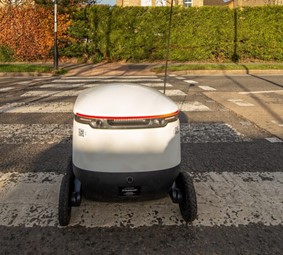
Source:
Google tax
- Context: India along with other G24 nations has called for gradual withdrawal of 'Google tax'.
- A Google tax, also known as a diverted profits tax, refers to anti-avoidance tax provisions that have been introduced in several jurisdictions to deal with the practice of profits or royalties being diverted to other jurisdictions that have lower or zero tax rates.
- For a long time, big foreign companies such as Google, Amazon, Facebook, Apple, Starbucks have managed to pay less corporate tax in some geographies by diverting their profits or royalties to other, low-tax jurisdictions (aka tax havens).
- In 2016, the Government of India (GoI) imposed a 6% “Equalisation Levy” (tax levied on payments for digital advertisement services received by non-resident companies without a permanent establishment in India if they exceeded $1,340 a year). This Google Tax was expanded in the 2020 Budget by adding foriegn-based e-commerce companies under its ambit.
- A tax rate of 2% (plus a surcharge) is now levied on the amount of consideration received/receivable by an e-commerce operator.

Sources:
Image Source:
Shree Padmanabhaswamy Temple
- Context: The Supreme Court has rejected Shree Padmanabhaswamy Temple trust's plea for audit exemption recently.
- Shree Padmanabhaswamy temple built in the unique Chera style of architecture, dates back to the 8th century situated in Thiruvananthapuram, the capital of Kerala.
- The present structure was built in the 18th century by the then Travancore Maharaja Marthanda Varma.
- The main deity of the temple is Lord Vishnu who is found in the Anantha Shayana posture (reclined posture of eternal yoga) on Adishesha or king of all serpents.
- The temple was first made of wood but later constructed with granite and has 365 pillars, one for each day of the year.
- It is considered to be world’s richest temple as it has uncounted wealth, stored in six enormous vaults that are believed to contain gold and precious stones worth billions of dollars.
- It is known to be one of the 108 holy temples associated with Vaishnavism in India.
- There are many festivals celebrated at the temple like Painkuni festival and Thiruvonam (marks the birthday of Sree Padmanabhaswamy).
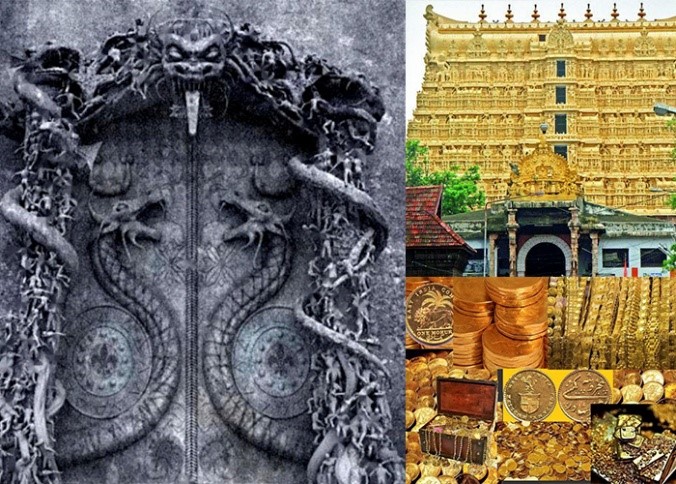
Sources:
- All about Padmanabhaswamy Temple, its treasures and the royal family that will control it
- Sree Padmanabhaswamy temple: A mysterious treasure
- SC rejects Shree Padmanabhaswamy Temple trust's plea for audit exemption
Image Source:
Logo for vegan foods: FSSAI
- Context: FSSAI has introduced a new logo for vegan food.
- The new green-coloured logo has a ‘V’ inscribed (in the middle of a square box) with a small planton top of it and vegan written at the bottom.
- It has been introduced to help consumers easily identify and differentiate vegan from non-vegan foods and empower them to make informed food choices.
- The design is such that it resonates with the current logo (that has a dot in the middle of a square) for vegetarian and non-vegetarian products.
- Veganism (vegan diet) is a kind of lifestyle that attempts to exclude all forms of meat and products that are derived from animals.

Source:
Image Sources:
- https://twitter.com/mansukhmandviya/status/1439974311628992524?ref_src=twsrc%5Etfw%7Ctwcamp%5Etweetembed%7Ctwterm%5E1439974311628992524%7Ctwgr%5E%7Ctwcon%5Es1_&ref_url=https%3A%2F%2Findianexpress.com%2Farticle%2Flifestyle%2Ffood-wine%2Ffssai-launches-vegan-logo-food-mansukh-mandaviya-label-crueltyfree-7526332%2F
- FSSAI launches logo for vegan foods; know more about it here
LiFi
- Context: India's highest altitude institute bacame the first to have LiFi network for faster internet.
- LiFi has been installed at the Ladakh- the Students' Educational and Cultural Movement of Ladakh (SECMOL).
- LiFi (light fidelity) is a bidirectional wireless system that transmits data via LED or infrared light.
- It means transmitting data with a light beam spectrum through open space in outdoor and indoor environments.
- LiFi systems provide ultra-fast data connections, and are especially useful in urban areas where radio spectra are congested and also useful in rural areas wherein Fiber Optic Cables or networks are not reachable.
- LiFi multiplies the speed and bandwidth of wifi, 3G and 4G.The latter have a limited capacity and become saturated when the number of users surfing increases, causing them to crash, reducing speeds and interrupting the connection.

Sources:
- India's highest altitude institute in Ladakh gets LiFi network for faster internet
- LiFi, the internet at the speed of light
Image Source:
A climate change narrative that India can steer- TH
Essence: Assessment of climate change over the Indian Region report revealed that India has warmed up 0.7° C during 1901-2018. India has suffered two of the 10 most expensive climate disasters, Cyclone Amphan and monsoon flooding in the last two years. Also, India’s Internally Displaced Populations (IDPs) are rising due to climate change induced coastal erosion, land erosion and natural disasters.
Experts view that India’s polices on climate change are good but India has overpromised on policies and goals. According to India’s carbon emission trajectory, the country can achieve only 50% of the pledged carbon sink by 2030. The Glasgow COP26 is a great opportunity for India to improve its global positioning by leading a favorable climate goal aspiration for the world to follow.
Why you should read this article?
- To understand the impact the climate disasters on India
- To understand the nature of climate policies and their impact
Source:
A disease surveillance system, for the future- TH
Essence: Prevention is better than cure. The article talks about the importance of disease surveillance system, i.e. systematic data collection, analysis and creation of preventive and management measures for disease handling. It would either prevent the outbreak or stop further spread. India is running the Integrated Disease Surveillance Project to investigate and detect disease outbreaks in time. Emergence and re-emergence of new and old diseases and an increase in cases of endemic diseases are partly unavoidable. Thought the outbreak cannot be prevented but certainly the impact can be reduced as in the case of Kerala which has a robust disease surveillance network.
Why you should read this article?
- To understand the need for disease surveillance system.
- How the system should be made robust to tackle the disease outbreaks.
- Understand the progress of IDSP in north and south India
Source:
Women Leaders in Border Road Organisations
Background
- Participation: Women participation in India’s defence as equals has been a long and hard-fought battle.
- SC Judgement: With the approval of women to have full commission in the armed forces, various divisions of defence have started to promote women officers to higher ranks.
- The Border Roads Organisation initiated a plan to create four women-led road construction projects in forward areas along the India-China border.
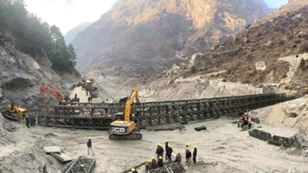
BRO initiative
- Empowerment: BRO plans to create four women-led road construction companies (RCC) to handle projects in forward areas along the India-China border.
- Participation: Women will be active participants in the endeavour of nation building.
- Self Esteem: To empower the female force with authority, responsibility, and respect.
- Setting Example: the initiative sets the tone for women participation in various capacities in defence sector and breaking the stereotypes.
Quote
“Women belong in all places where decisions are being made.”- Ruth Bader Ginsburg
Source:
Share the article
Get Latest Updates on Offers, Event dates, and free Mentorship sessions.

Get in touch with our Expert Academic Counsellors 👋
FAQs
UPSC Daily Current Affairs focuses on learning current events on a daily basis. An aspirant needs to study regular and updated information about current events, news, and relevant topics that are important for UPSC aspirants. It covers national and international affairs, government policies, socio-economic issues, science and technology advancements, and more.
UPSC Daily Current Affairs provides aspirants with a concise and comprehensive overview of the latest happenings and developments across various fields. It helps aspirants stay updated with current affairs and provides them with valuable insights and analysis, which are essential for answering questions in the UPSC examinations. It enhances their knowledge, analytical skills, and ability to connect current affairs with the UPSC syllabus.
UPSC Daily Current Affairs covers a wide range of topics, including politics, economics, science and technology, environment, social issues, governance, international relations, and more. It offers news summaries, in-depth analyses, editorials, opinion pieces, and relevant study materials. It also provides practice questions and quizzes to help aspirants test their understanding of current affairs.
Edukemy's UPSC Daily Current Affairs can be accessed through:
- UPSC Daily Current Affairs can be accessed through Current Affairs tab at the top of the Main Page of Edukemy.
- Edukemy Mobile app: The Daily Current Affairs can also be access through Edukemy Mobile App.
- Social media: Follow Edukemy’s official social media accounts or pages that provide UPSC Daily Current Affairs updates, including Facebook, Twitter, or Telegram channels.

